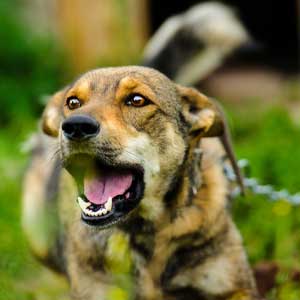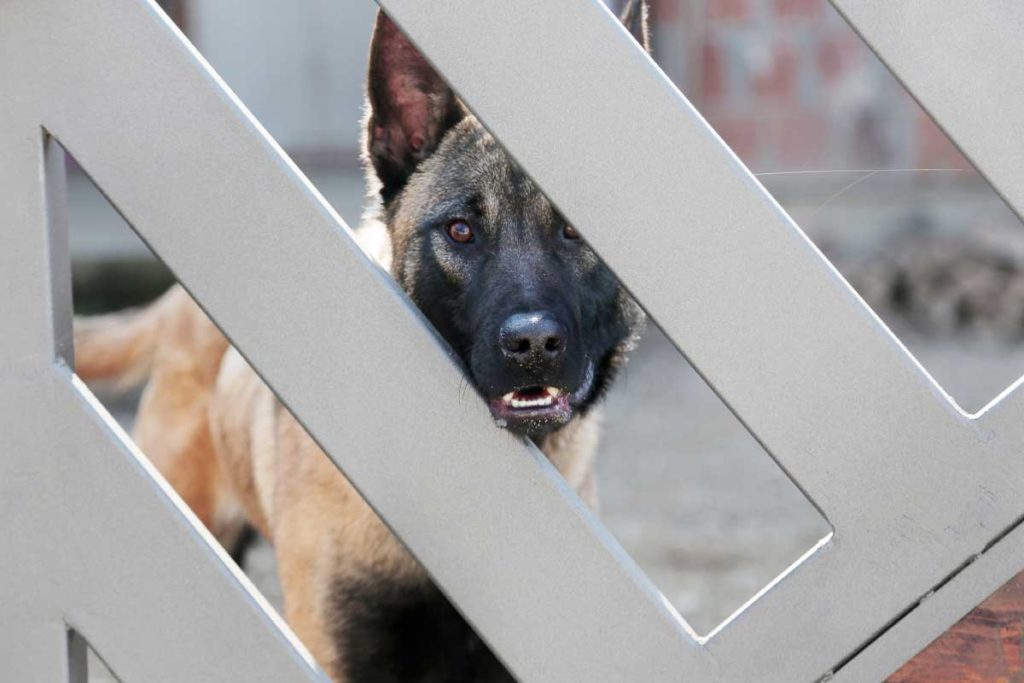Reviewed by: Dr. David Tittle, BVetMed, CertVA, GPCert(WVA&CPM), MRCVS
The mail carrier approaches your house, and your dog is at the window barking. Your dog may also constantly patrol your yard, ready to bark at anyone who walks by. Territorial behavior like this can be stressful for you, your dog, and anyone trying to approach your home. While your dog alerting you to a potential threat can be helpful, territorialism can quickly become dangerous. So, how do you tell the difference between normal behavior and being territorial, and what can you do?
Table of contents
- Why is my dog territorial?
- Barriers and territorial behavior
- Am I making my dog’s territorial behavior worse?
- Signs of territorial issues
- Addressing territorial aggression
- Stay positive
- How can ElleVet’s CBD + CBDA help stressed dogs?
- Preventing territorial behavior
Why is my dog territorial?
Aggressive behavior in dogs can be driven by a variety of causes, including fear and protectiveness. These are often labeled as territorialism when they occur at home. Understanding why your dog is stressed and appears territorial helps you address the root causes of their aggressive behavior.
Fear
Many dogs who show territorial responses are often fearful and simply want the perceived intruder to leave. Fear-based aggression occurs when a dog feels they cannot escape a threat and experiences heightened stress. This is often the case when a stranger or unfamiliar animal invades a dog’s territory. With this, fear often plays a significant role in behavior labeled as territorialism.
The Veterinary Centers of America note that fear is perhaps the most common cause of aggression in dogs. It is common for shelter dogs to show signs of territorial behavior, as these dogs have likely developed fear of unknown and perceived threats to their space and safety.
Protective instincts
Dogs are instinctively protective of their family and home. Most forms of territorial aggression occur at home when a dog feels their space is invaded, according to VCA Animal Hospitals.
While all dogs can develop territorial behaviors, some breeds have been traditionally bred to herd animals or guard people, places, or resources. For example, Trupanion notes that Akitas and Doberman Pinschers were bred as guard dogs and can be prone to territorial behavior.
Barriers and territorial behavior
Some dogs who are prevented from accessing an “intruder,” either by a fence, door, or leash, can be more territorial, notes the Spruce Pets. A barrier between a dog and a stranger prevents the dog from directly fending off the perceived threat, according to the Best Friends Animal Society. Barriers can also create additional tension during social interactions. They can prevent dogs from meeting people and other pets in a natural, non-threatening way. This stress can manifest as aggression.
Research from the Tufts University Cummings School of Veterinary Medicine shows that electric or invisible fences can make territorialism worse. Regular fencing is bilateral. Not only is your dog unable to get out, but people and other animals are unable to come in. A physical fence also serves as a visual boundary, signaling to strangers that they should not enter your dog’s space. With this, your dog and family are safe inside.
Electric fences, however, are unilateral in function. While your dog cannot get out, anyone can come in and strangers are more likely to invade your dog’s space. Tufts warns that this inability for dogs to effectively guard their property can make a dog highly stressed. This can create bullying behavior in timid dogs as they try to keep intruders away. They feel unsafe and show this as aggression.
Am I making my dog’s territorial behavior worse?
Due to the nature of the scenarios in which dogs are likely to show territorial behavior, these behaviors can be easily reinforced. For example, the mail carrier comes to the house, the dog barks, and the mail carrier leaves. They do not leave because the dog barked at them but because they have completed their job. But the dog does not make this connection, and instead takes credit for the mail carrier’s retreat. Lack of owner supervision for territorial dogs exacerbates problem behavior, as the dog is not interrupted and corrected.
Signs of territorial issues
It is important to be able to recognize signs of territorial behavior in your dog to avoid potentially dangerous incidents. Warning cues can quickly escalate to aggression. Monitor your dog for:

- Warnings—Territorial behavior often starts with disruptive or annoying warning cues, such as barking. These behaviors are intended to intimidate the intruder, as well as alert other pack members (i.e. human family) that there is perceived danger.
- Escalation—Barking can escalate to more dangerous behaviors. Dogs may growl, lunge, and even bite if they feel threatened or challenged.
- Protectiveness in other places—You may also notice that your territorial dog exhibits similar behaviors in other situations. Dogs who are territorial over their home may also be protective over their family members when out in public. They can also show signs of resource guarding around their toys and food at home.
Addressing territorial aggression
If your dog struggles with territorial aggression, it is important to avoid triggers as much as possible. New negative experiences can make stress and fear worse. Repeated behaviors will inevitably become habits and escalate, according to veterinarian Dr. Lore Haug. Keep the blinds down if you have a window barker. Ask guests to text you rather than ring the doorbell when they arrive at your house.
Any aggression needs the intervention of a trainer or veterinary behaviorist. Ask your veterinarian for recommendations for dog trainers and enlist their help right away. Many people inadvertently make the behavior worse, and aggression needs to be handled by a professional.
Stay positive
Positive techniques are essential for successfully training dogs. According to AKC, dogs that are trained using positive methods learn to enjoy training and develop an eagerness to please.
In the case of territorial behavior, use positive reinforcement with desensitization and counterconditioning. Help your dog to gradually get comfortable with strangers and other pets in their “territory.” Help them learn that “intruders” bring pleasant experiences for them. Have visitors give treats when they come in the door—and only after your dog settles—to help your dog associate visitors with a positive.
Punishment does not work! Punishing your dog can increase fear, stress, and aggression. Your dog will learn to associate strangers with negative experiences. Eventually, it is possible that your dog will learn to not warn you when they are uncomfortable in the future. This contributes to seemingly calm dogs showing aggression “out of nowhere.”
How can ElleVet’s CBD + CBDA help stressed dogs?

ElleVet’s CBD + CBDA chews, soft gels, and oils can offer support for your dog’s stress levels, helping relax and calm them. This can allow your dog to become calm enough to manage their stress and fear-based response. In addressing your dog’s stress, ElleVet’s CBD + CBDA can lead to improved overall well-being and a happier, less fearful dog. Consult your veterinarian if your dog shows any indications of aggression escalating beyond barking.
Preventing territorial behavior
Early socialization for young puppies is essential to enjoying life with a well-adjusted dog down the road. Socialization helps dogs become comfortable with a variety of people, pets, and experiences. This helps them “go with the flow” and be less fearful of anything new.
Enroll your puppy in training classes and bring them with you while running errands. This will help them gain confidence in a variety of scenarios. You can also arrange for puppy playdates to teach your pup that other dogs are friends rather than threats.
Rescue dogs can be extremely fearful. A good trainer is invaluable in helping them manage and understand their new world and how to navigate stressful situations.
Good training and consistency are key to success. Your dog does not have to exhibit problem behavior for you to seek expert advice. A dog trainer or a reputable book or online training guide is invaluable in teaching your dog good manners and helping them manage and understand their world.








